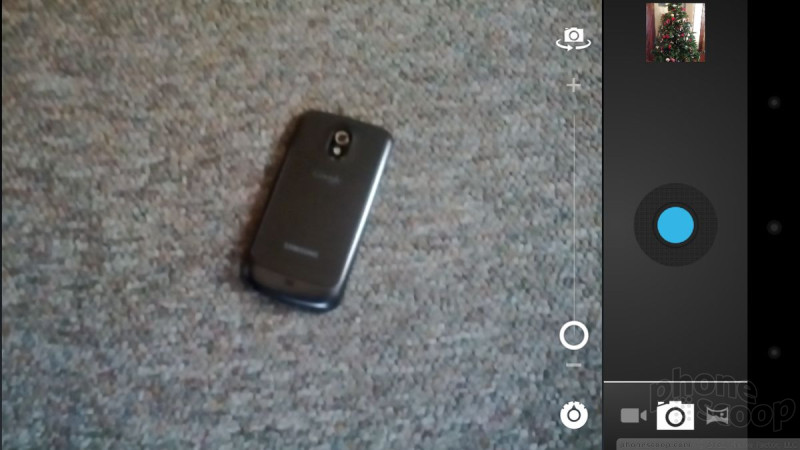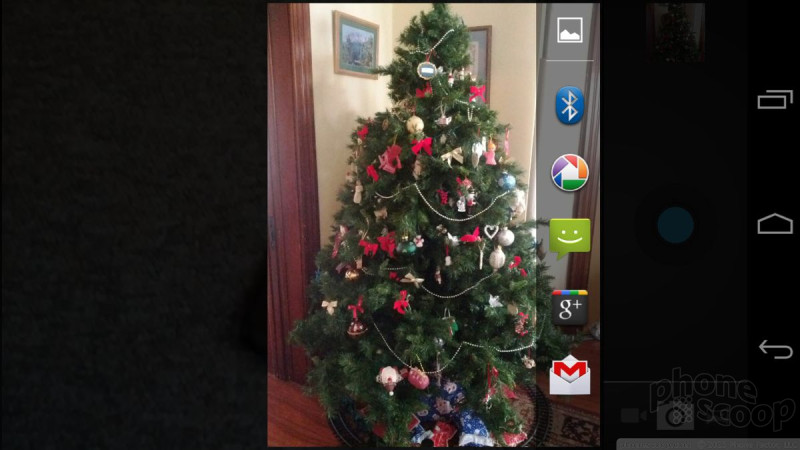Review: Samsung Galaxy Nexus for Verizon Wireless
Camera
I don't know what Google was thinking, but it half-maimed the camera software. Here's how.
Since there's no dedicated camera button, you have to launch the camera either from the lock screen or from the home screen / main menu. It loads instantly. So far, so good.
The viewfinder is broken up into two main parts: three-quarters viewfinder and one-quarter controls. The software shutter button is enormous, and I like that a lot. It is in a gray box that also has controls for accessing the video camera. It takes too long to switch to the video camera, in my opinion; it's at least two steps, when it should be only one. There's also a zoom tool, a switch to flip to the user-facing camera, and a way-too-small button to access the settings.
The settings let you adjust exposure, white balance, the flash, and scene modes. The list of scene modes is pretty anemic and only includes action, night, sunset, party, and auto. No panorama? No smile shot? No macro? No burst shot? What's going on here? Also, the control for changing the resolution of the image is confusing and doesn't work well.
The worst part, however, are the three dots that appear next to the shutter button. Though the three-dot configuration usually signifies the settings menu in Android 4.0, these three dots are really the Back, Home, and Multitask buttons in disguise. Pressing the first two closes the camera app, and the third opens the multitasking pane. Whichever you press, it slows you down and gets in the way of shooting photos. The problem is, seasoned Android users may end up pressing these by accident, based muscle memory alone, thinking they are hitting a hardware menu button. Or, once you get used to Android 4.0, the software settings menu. Either way, it may lead to missed moments.
But — and this is a big but — the camera is fast as hell. It is faster than every cell phone I've ever tested, and is faster than most point-and-shoots I've ever used. It is fast, Fast, FAST. You can take several pictures per second, that's how fast it is. It also supports touch-to-focus. Touch what you want the camera to concentrate on, it locks on in about a second and then instantly captures the image. I like that a lot. The speed is really helpful.
Gallery
The new gallery application is excellent. If you go to the gallery straight from the camera — accessible by pressing a little thumbnail image — the image is peppered with sharing options, such as Gmail, Google+, etc. This makes sense, as you most likely want to share the image you just took. However, you can press another button and go to the main gallery, which is cleaner looking than the Gingerbread gallery, and offers a nice set of tools for interacting with your images.
The central image library ties together all the photos associated with your Google accounts, including Picasa and Google+. All the albums you have in those services are available from the Galaxy Nexus, and you can sync them to the device for offline access if you want.
When you dive into individual libraries, the images are arranged in vertical columns that I really liked. They have an authoritative look to them. Poke the image you want to manipulate and it loads in a jiffy. The image fills most of the screen, but there's a ribbon that stretches across the bottom so you can jump to other images in the library fairly quickly.
Up top, you'll see the sharing tool, which opens a drop-down menu with the options such as Gmail, Picasa, Bluetooth, etc. You can also trash the image, or hit the menu button (those three tiny little dots again!) to open the full menu. Through this tool, you can start a slide show, edit the photo, crop or rotate the photo, see the image details, and set it as your wallpaper or as a contact.
Editing features include the ability to add effects, such as highlights, shadows, and so on; add filters such as vingetting, fisheye effects, etc.; adjust colors and tones with sepia, B&W, etc. The last tool lets you crop the image, fix red-eye, adjust for face glow (with flash photography), straighten images, rotate or flip them, and sharpen them.
That's some solid functionality. Well done, Google.


















 Hands-On: Android 4.1 Jelly Bean
Hands-On: Android 4.1 Jelly Bean
 Sprint Officially Reveals Galaxy Nexus
Sprint Officially Reveals Galaxy Nexus
 Samsung Galaxy Nexus First Ice Cream Sandwich Phone
Samsung Galaxy Nexus First Ice Cream Sandwich Phone
 Samsung Galaxy Nexus (LTE)
Samsung Galaxy Nexus (LTE)







